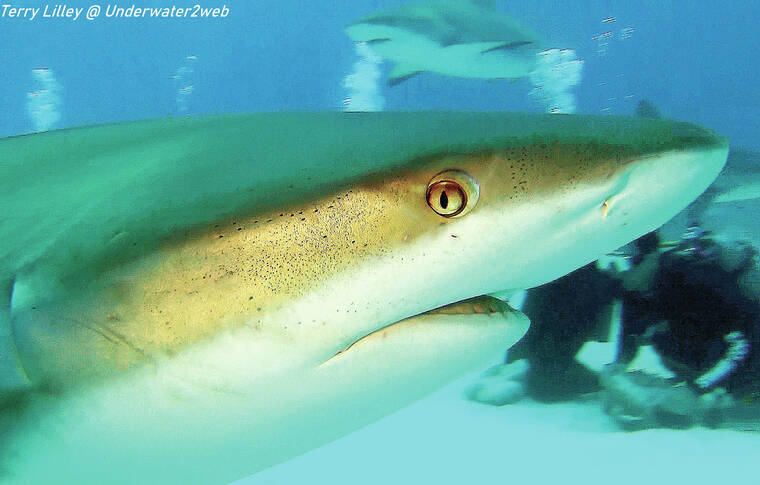Large sharks have been a part of Hanalei Bay way before humans ever showed up in Hawai‘i, and we are still learning about their behavior everyday.
Recently, there was a shark bite on a surfer in the bay and that makes us surfers a little bit concerned that it may happen again. If we understand how sharks feed and why we are not on their menu we can go into the water and not worry about being bitten or eaten by a large tiger shark.
I scuba dive with large tiger or great white sharks often, including from time to time in Hanalei Bay and they just ignore me. Recent research has shown why these giant predators don’t eat people, but sometimes accidentally bite surfers.
If you pay attention to shark attacks in Hawai‘i, you will notice people get bit but the shark does not come back and eat them. No large predator would make a mortal bite on its prey then just leave the food behind so why are large sharks safe to dive with?
Large sharks are warm blooded and they need a lot of fat in their diet to survive. Land animals from people, pigs and cows have a lot of bones to keep our body ridge so we can move upright under the effects of gravity.
Marine animals float so they do not need so many bones. A dolphin, whale, tuna and sea turtle all have a high fat content versus bone material. Shark teeth are designed to bite through fat and muscle, not bone and they know how to tell if an animal in the sea is worth eating or not.
Tiger sharks teeth are short and fat and have a serrated edge. When they eat a sea turtle they bite off the turtle’s flipper and wait for the turtle to bleed to death. They then slowly saw through the shell to eat the inside of the turtle where there are no bones.
If a tiger shark was to bite a person it would lose many of its teeth when it connected with bone versus fat. The shark would spend more energy eating a human that it would get back in food value.
This also happens with other land animals like cows, bison and pigs. After the 2018 Hanalei flood, lots of land animals got washed out into the bay, but the tiger sharks did not try to eat them.
Big sharks have a lateral line along their sides and while the shark swims it puts out waves into the sea. These waves bounce off of potential prey and come back to the shark. The rate at which the waves come back lets the shark know how dense the prey item is.
They can tell if the prey is full of bones or full of fat. They won’t eat the bony land animals. Sharks also have electromagnetic sensors on their head that can detect the electrical output of an animal from a great distance away. Animals with a high fat content put out a different electrical signal versus animals like us that are full of bones.
When a big shark is chasing its natural prey like a small sea turtle, it will shut its eyes and turn off its sensors right before an attack. If a human gets between the shark and its prey at this time the shark does not have time to figure out which is which, a turtle or a surfers limb. So sometimes we accidentally get bit. Once the shark realizes it bit the wrong thing it lets go and goes on its way.
If we understand statistics we will see that sharks rarely bite people even though they could easily do so. On average 12, people a year in the world get killed by sharks but 500 get killed by bee stings.
About 200 people get killed by dogs and over 100 people get killed by falling coconuts. Another 3,500 get killed in car accidents driving to the beach to get in the water with the sharks.
I have a new movie out called, “Diving With 3,000 Sharks ” which I show in my school classroom presentations and it is a good movie to watch if you are a surfer, swimmer, diver or paddler so you can have fun in the sea and not worry so much about sharks. The link is at https://youtu.be/foeGma_yhy8.
•••
Terry Lilley is a marine biologist living in Hanalei Kaua‘i and co-founder of Reef Guardians Hawai‘i, a nonprofit on a mission to provide education and resources to protect the coral reef. To donate to Reef Guardians Hawaii go to www.reefguardianshawaii.org.





